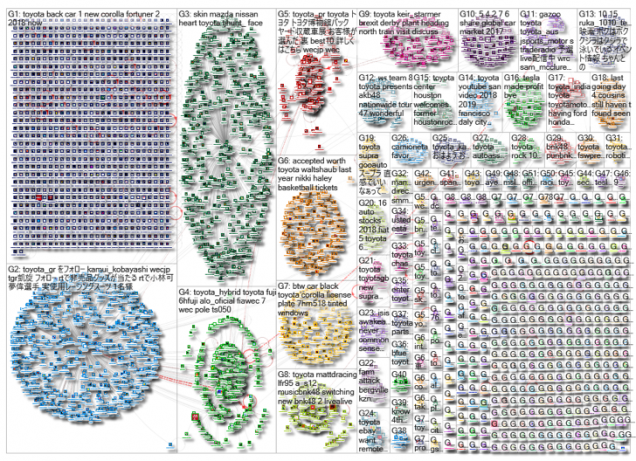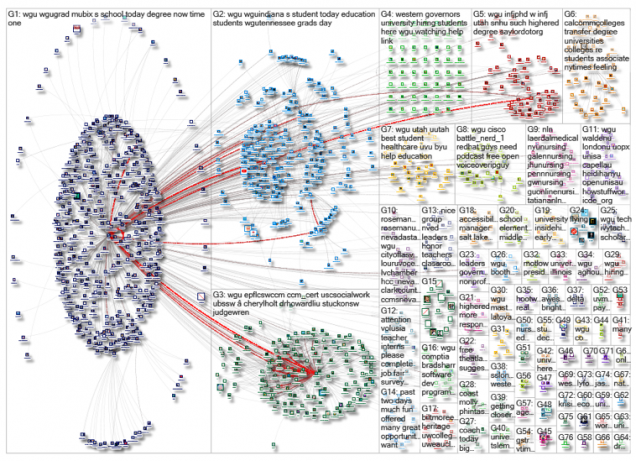In the NodeXL graph gallery, various graphs convey a lot of information, not only the size and structure of the network, but also the words, hashtags, and URLs people used. The graph below represents a network of 5,181 Twitter users whose tweets in the requested range contained “Toyota,” or who were replied to mentioned in those tweets.

Figure 1: Toyota_2018-10-14
When it comes to the Brand Cluster network structure, Smith and his colleagues pointed out that when well-known products or services or popular subjects are discussed in Twitter, there is often commentary from many disconnected participants. (Smith et. al, 2014) Indeed, in the left part of the graph, we can see isolated participation in the conversation. Most of the users share the common attribute of having mentioned “Toyota,” but they lack any connection to one another. Apparently, this is different from the form of the polarized crowd which features two big and dense groups. This is because as a well-known brand such as “Toyota,” it has a large scale of individuals who are interested in or have a sort of connection with the brand. Moreover, these individuals are also more widespread and isolated, implicating the disconnection among most of the participants. Some small interconnected groups of users forming around brands and topics in the “Toyota” graph are also worth mentioning. Rather than having polarizing points of view, keywords of these various groups are quite different and topics in this cluster varies. Users in Brand Cluster discuss “Toyota” from different dimensions because they interested in such a big-name brand and are more likely to have different opinions, which contribute to the formation of such type of network structure. In fact, Brand Cluster network structure may satisfy the marketing and communication department of Toyota since plenty of disconnected individuals contribute to the topics and numbers of networked individuals expand the influence of the topic, increasing the brand’s exposure.
The graph below shows another type of network structure. 1,434 Twitter users used terms “western governors university” or “@wgu” in their tweets or users who were replied to or mentioned in those tweets. This is similar to Broadcast Networks type which is discussed in Smith’s article.

Figure 2: (western governors university) OR @wgu_2018-10-13
As Smith and his colleagues stated, “the broadcast network structure is dominated by a hub and spoke structure, with the hub often being a media outlet or prominent social media figure, surrounded by spokes of people who repeat the messages generated by the news organization or personality.” (Smith et. al, 2014) The overall top replied-to and influencer is @wgu, the official university account, which is the center of broadcasting. Most of the network audience in this graph are connected only to the hub news without connecting with each other, and for the sub-groups in which people are densely connected, they might be the people who discussed the news with each other. Looking into the top words in tweets in different groups, people adopt similar words, for example, “wgu” appears almost in every graph. The reason can be that users’ conversation starts with the words and references of the broadcaster, making the words that people choose are quite similar. (Smith et. al, 2014)
Smyrnaios introduced the concept of Informadiation, which is a set of social-technical mechanisms that provide internet users with all types of information online and connect them with other users. (Smyrnaios, 2018) As one of the infomediaries, Twitter not only provides information but also connects people together. Besides, Rainie & Wellman(2012) mentioned that “The short-form messaging site is primarily about passing along important—often breaking—information in a way that unifies or assumes shared values within the Twitter community.” Looking into two types of networks structure discussed in the graphs, even though some difference exists, the common interest or values that users share easily gather them together into groups on Twitter. As a consequence, the conversation starts, and people are connected.
“Making is connecting.” put forward by sociologist David Gauntlett. People nowadays not only be able to create their original work using materials online and offline, but they also encourage networked individuals to do so collaboratively. Rainie & Wellman(2012) described that using social media such as Twitter, networked individuals extend their reach and their potential for influences, blurring boundaries between producers and consumers. Tweets and comments, both as user-generated content, are powerful when created by networked individuals, to some degree expanding the influence of the topic. In fact, this kind of network structure exerts a significant impact on the conversation, if the top influencer who can be enterprise, organization or well-known individuals, have loyal and a large number of followers.
In sum, users play a crucial role in the formation of social networks. The interaction between socially networked users and user-generated content should be attached great importance to. The two graphs discussed shows two different type of networked system, both influenced by Infomediation and Vertical Integration. Overall, it is reasonable to say Infomediation and Vertical Integration shape this type of networked type, and what influence that social network will bring is a topic that deserves further discussion.
Citation
Smith, M. A., Rainie, L., Shneiderman, B., & Himelboim, I. (2014, February 21). Mapping Twitter Topic Networks: From Polarized Crowds to Community Clusters | Pew Research Center. Retrieved from http://www.pewinternet.org/2014/02/20/mapping-twitter-topic-networks-from-polarized-crowds-to-community-clusters
Rainie, L., & Wellman, B. (2012). Networked, The New Social Operating System. Cambridge, MA: The MIT Press.
Smyrnaios, N. (2017). Internet Oligopoly, The Corporate Takeover of Our Digital World (A. Karatzogianni, Ed.). Emerald Publishing.
Toyota_2018-10-14_05-17-55.xlsx(October 14, 2018)Retrieved from https://nodexlgraphgallery.org/Pages/Graph.aspx?graphID=171356
(western governors university) OR @wgu_2018-10-13_00-33-37.xlsx (October 13, 2018) Retrieved from https://nodexlgraphgallery.org/Pages/Graph.aspx?graphID=171254